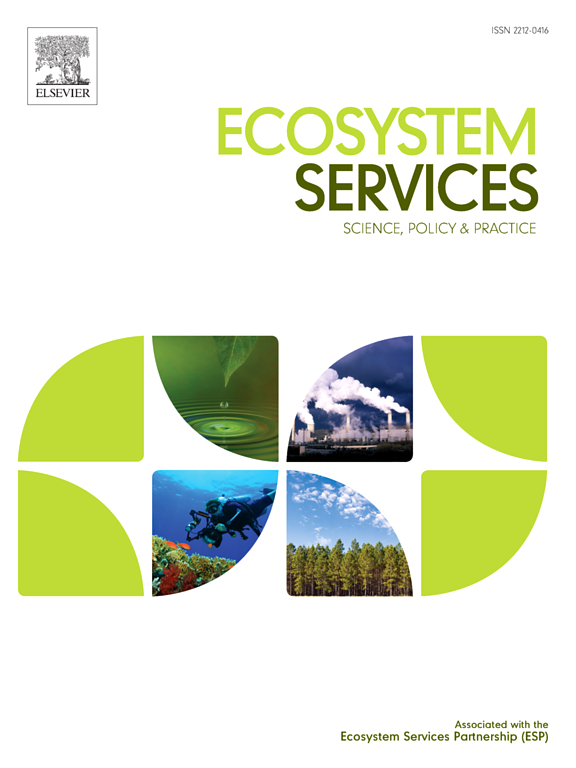Contributions of stakeholder perspectives and biophysical mapping to assess ecosystem services in the Upper White Nile basin
IF 6.6
2区 环境科学与生态学
Q1 ECOLOGY
引用次数: 0
Abstract
The wellbeing and livelihoods of local communities are threatened by global changes that affect ecosystem services. This study addresses the gap in comprehensive ecosystem services assessment and uses the Co$tingNature mapping tool and stakeholder’s perceptions to examine the spatial distribution of ecosystem service magnitudes and perceived local value in the Upper White Nile basin in East Africa, an area facing significant resource pressures. The analysis reveals a heterogeneous distribution of ecosystem services, with a notable concentration of ecosystem service delivery in the western regions of the basin in Uganda. The Co$tingNature assessment emphasises the widespread spatial distribution of carbon storage and sequestration and agriculture related services, while stakeholders highly value more localised services such as water provision and artisanal fisheries. Using both methods proves crucial, as Co$tingNature offers cost-effective whole-area spatial assessments, whereas stakeholder perceptions provide insights into local concerns and values. This study underscores the importance of complementing global tools with local knowledge, as these tools may otherwise lack relevance in local policy spheres. By incorporating stakeholder perspectives into conservation planning, the study highlights the need to integrate aquatic and agriculture-related ecosystem services into local policies and conservation strategies in the Upper White Nile basin. Leveraging tools like Co$tingNature alongside stakeholder perspectives enhances our understanding of ecosystem dynamics and facilitates more effective environmental management strategies in the region. This combined approach offers a practical framework for ecosystem service assessments that can both contextualise and mobilise conservation efforts, bridging the gap between locally valued services and those with global significance.
利益相关者视角和生物物理制图对上白尼罗河流域生态系统服务评估的贡献
影响生态系统服务的全球变化威胁着当地社区的福祉和生计。本研究解决了综合生态系统服务评估的差距,并使用Co$tingNature地图工具和利益相关者的感知来检查东非白尼罗河上游流域生态系统服务规模的空间分布和感知的当地价值,这是一个面临重大资源压力的地区。分析表明,生态系统服务的分布具有异质性,乌干达盆地西部地区的生态系统服务提供明显集中。《Co$tingNature》评估强调了碳储存和封存以及与农业相关的服务的广泛空间分布,而利益相关者高度重视供水和手工渔业等更本地化的服务。使用这两种方法至关重要,因为Co$tingNature提供了具有成本效益的全区域空间评估,而利益相关者的看法则提供了对当地关注点和价值观的见解。这项研究强调了用当地知识补充全球工具的重要性,因为这些工具在当地政策领域可能缺乏相关性。通过将利益相关者的观点纳入保护规划,该研究强调了将水生和农业相关生态系统服务纳入白尼罗河上游流域当地政策和保护战略的必要性。利用像Co$tingNature这样的工具和利益相关者的观点,增强了我们对生态系统动态的理解,并促进了该地区更有效的环境管理战略。这种综合方法为生态系统服务评估提供了一个实用的框架,既可以将保护工作置于背景下,又可以调动保护工作,弥合地方价值服务与具有全球意义的服务之间的差距。
本文章由计算机程序翻译,如有差异,请以英文原文为准。
求助全文
约1分钟内获得全文
求助全文
来源期刊

Ecosystem Services
ECOLOGYENVIRONMENTAL SCIENCES&-ENVIRONMENTAL SCIENCES
CiteScore
14.90
自引率
7.90%
发文量
109
期刊介绍:
Ecosystem Services is an international, interdisciplinary journal that is associated with the Ecosystem Services Partnership (ESP). The journal is dedicated to exploring the science, policy, and practice related to ecosystem services, which are the various ways in which ecosystems contribute to human well-being, both directly and indirectly.
Ecosystem Services contributes to the broader goal of ensuring that the benefits of ecosystems are recognized, valued, and sustainably managed for the well-being of current and future generations. The journal serves as a platform for scholars, practitioners, policymakers, and other stakeholders to share their findings and insights, fostering collaboration and innovation in the field of ecosystem services.
 求助内容:
求助内容: 应助结果提醒方式:
应助结果提醒方式:


